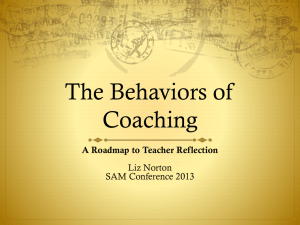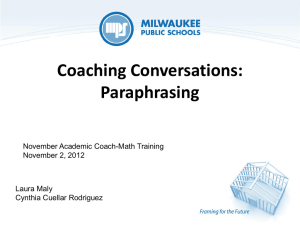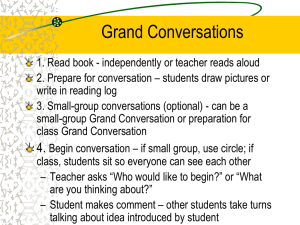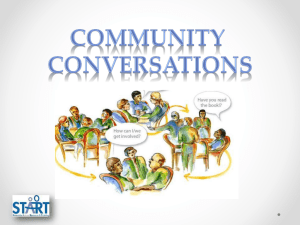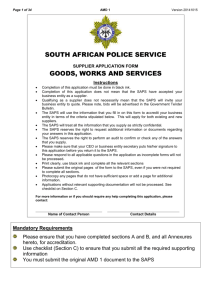Coaching Protocol for Post-Observation
advertisement
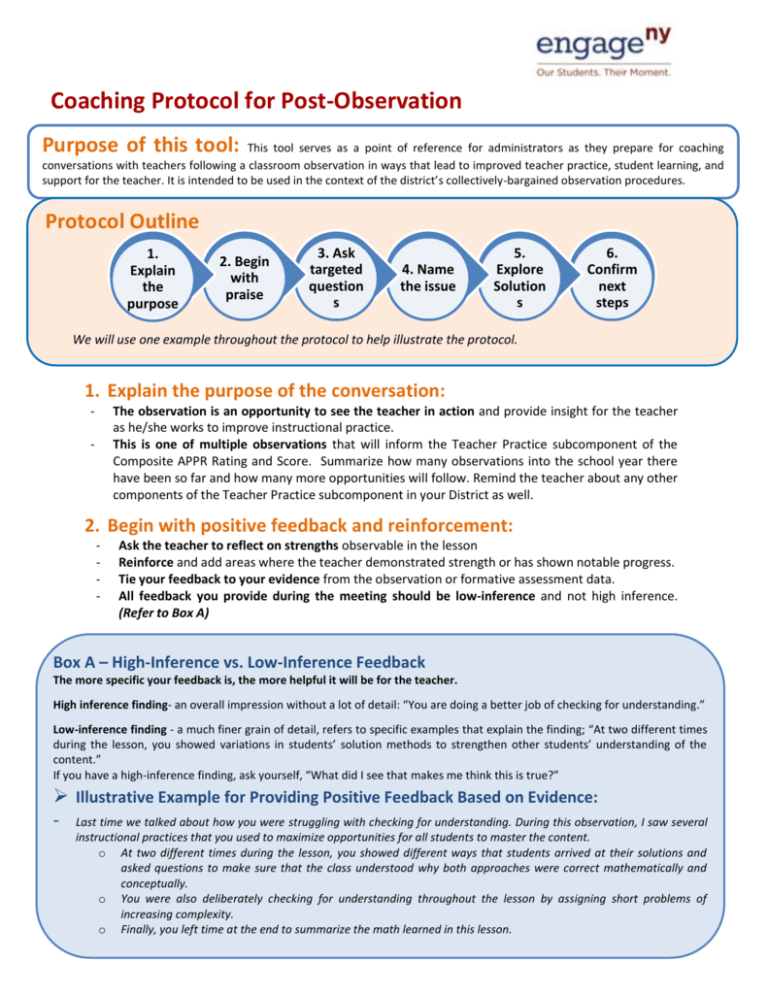
Coaching Protocol for Post-Observation Purpose of this tool: This tool serves as a point of reference for administrators as they prepare for coaching conversations with teachers following a classroom observation in ways that lead to improved teacher practice, student learning, and support for the teacher. It is intended to be used in the context of the district’s collectively-bargained observation procedures. Protocol Outline 1. Explain the purpose 2. Begin with praise 3. Ask targeted question s 4. Name the issue 5. Explore Solution s 6. Confirm next steps We will use one example throughout the protocol to help illustrate the protocol. 1. Explain the purpose of the conversation: - The observation is an opportunity to see the teacher in action and provide insight for the teacher as he/she works to improve instructional practice. This is one of multiple observations that will inform the Teacher Practice subcomponent of the Composite APPR Rating and Score. Summarize how many observations into the school year there have been so far and how many more opportunities will follow. Remind the teacher about any other components of the Teacher Practice subcomponent in your District as well. - 2. Begin with positive feedback and reinforcement: - Ask the teacher to reflect on strengths observable in the lesson Reinforce and add areas where the teacher demonstrated strength or has shown notable progress. Tie your feedback to your evidence from the observation or formative assessment data. All feedback you provide during the meeting should be low-inference and not high inference. (Refer to Box A) Box A – High-Inference vs. Low-Inference Feedback The more specific your feedback is, the more helpful it will be for the teacher. High inference finding- an overall impression without a lot of detail: “You are doing a better job of checking for understanding.” Low-inference finding - a much finer grain of detail, refers to specific examples that explain the finding; “At two different times during the lesson, you showed variations in students’ solution methods to strengthen other students’ understanding of the content.” If you have a high-inference finding, ask yourself, “What did I see that makes me think this is true?” Illustrative Example for Providing Positive Feedback Based on Evidence: - Last time we talked about how you were struggling with checking for understanding. During this observation, I saw several instructional practices that you used to maximize opportunities for all students to master the content. o At two different times during the lesson, you showed different ways that students arrived at their solutions and asked questions to make sure that the class understood why both approaches were correct mathematically and conceptually. o You were also deliberately checking for understanding throughout the lesson by assigning short problems of increasing complexity. o Finally, you left time at the end to summarize the math learned in this lesson. 1 3. Ask targeted questions to help lead the teacher to the core issue: - Plan to address no more than two to three opportunities for improvement during this postobservation conversation. However, be flexible about other topics the teacher suggests as well. Begin by asking the teacher specific questions that may lead a teacher to identify the areas of improvement before you do. (Refer to Box B Reinforce the teacher’s suggestions or further probe as needed, focussing on low inference evidence this and other recent observations, as well as formative studen assessment data. - Box B – Targeted Questions The more specific your questions, the more likely the teacher can name the issue before you do. OK: Was there anything you thought you could have done better while I was observing the class? Better: Who was doing the heavy thinking and lifting during the lesson – you or the students? How do you know? How much time during the lesson were you talking at the students versus the students working and thinking? Best: Did you let students struggle with difficult questions or did you step in and lead them or answer the question for them? What could you have said or asked to push students to more clearly and accurately reflect their mathematical understanding of this concept? 4. Name the issue(s) together: There should be no ambiguity about the opportunity for improvement. How much you explicitly name the issue versus giving the teacher the opportunity to do so depend on the nature of the issue and the teacher’s ability to identify the concern. - Teacher-driven - The teacher recognizes the issue independently and is able to recommend solutions and next steps. - Shared - The administrator guides the teacher to the issue. - The administrator and teacher share their ideas on the solution together. Administrator-driven - The administrator names the problem and specifies the required next steps. Focus again on low-inference feedback. o E.g., instead of “You are too quick to give the students the answers instead of waiting for them to figure it out,” provide low-inference feedback like, “During two of my observations, when you worked with your lower-achieving students, you waited for them to give 2-3 wrong or insufficient answers before you pointed them to the answer in the text, or you gave them the answer.” 2 5. Explore solutions together: - Explore with the teacher what changes to practice could address each area of improvement. The teacher may have specific ideas to offer, or may be able to do so with guiding questions. In our current example, the teacher may be struggling with increasing student engagement and thinking. He may be anxious to get through all lesson materials and the questions he planned for students to answer. He also may have a limited toolkit of ways to facilitate a classroom where all students are productively engaged in the work of the lesson. Together you might brainstorm 4 or 5 ways that he can give more time for certain groups of students, plan more questions to push for students to “work” for the answers, model perseverance, or build a classroom culture where students persist in efforts to read, speak, and write about demanding texts even when it gets hard. - Brainstorm together about the different resources available, and the kind of support that will help improve instructional practice. The more specific the action plan is, the more helpful it will be. You and the teacher may be able to construct specific new practices together in the moment and make plans for immediate follow-up. Two examples from Paul BambrickSantoyo’s book Leverage Leadership: Role play the new practice you’ve brainstormed together. E.g., have the teacher try out how he would either ask more questions to push students to persevere, or wait for students to struggle to come up with the answers themselves. Script changes into lesson plans. For example, write in questions the teacher can use to push students to work for the answers, or devise ways to increase the time students have to read and write on their own. Model precisely what higher performance looks like. Then, walk through a revision to the next day’s lesson plan. Or the development areas may be better addressed by discussing together how specific ongoing coaching, professional development activities, collaboration with other teachers, etc. can help the teacher identify and incorporate new practices to address the development areas. Be sure to think broadly together about the full range of District and school resources to help the teacher. 6. Confirm next steps: - - Summarize the follow-up steps expected to take place following the meeting. Ensure that you have clear actions, owners and timelines. Agree to something that you will follow up on immediately following the conversation, like the teacher will watch a video on best practices on EngageNY.org, or the teacher will ask a teacher highly effective in this technique to observe and provide feedback in a week. Schedule the follow up conversation, matching the timing with the urgency for improvement. 3 Setting the Stage Enabling conditions that make coaching conversations a lot more productive: 1. The conversation follows a course of regular interaction between the principal and the teacher about 2. 3. 4. 5. 6. what is working well and what opportunities exist to improve instructional practice. Teachers understand that the principal is focused first and foremost on student achievement and whether or not students are engaged and learning. The principal is therefore committed to supporting teacher effectiveness and establishing constructive teaching & learning conditions. From the beginning of the school year, the principal has shared her/his expectations of what great instruction looks like, and visits classrooms regularly to observe instruction. The school environment promotes risk-taking, creating a safe environment for learning and innovation, and candid reflection on what is or isn’t working well in the classroom. Teachers and staff feel free to raise issues and ask for help and support when they need it. The principal regularly cross-pollinates, sharing best practice and leveraging the strengths of teachers in the building to develop others. The principal trusts that the teacher can handle constructive criticism and put it to good use. Relate the evidence to your District's practice rubric and identify strengths and areas of improvement to focus on . Consider how to let the teacher lead as much of the conversation as possible with your asking probing questions , rather than telling the teacher what to do. Adjust your style to the teacher Stick to the evidence Watch your emotions and take brief breaks if needed Share encouragement and support for the teacher Leave with clear expectations on next steps After Review the evidence from the observation and plan some low inference points to use in your discussion. During Before Best Practices for a Successful Conversation Follow up immediately on planned actions Observe the teacher within the week to check for changed practice Check-in with the teacher on progress within the next two weeks Bibliography Bambrick-Santoyo, Paul. (2012) Leverage Leadership.San Francisco, CA: Jossey-Bass. City, Elizabeth, Elmore, Richard F., Fiarman, Sarah E., Teitel, Lee.(2009) Instructional Rounds in Education. Cambridge, MA: Harvard Education Press. Marshall, Kim. (2009) Rethinking Teacher Supervision and Evaluation. San Francisco, CA: Jossey-Bass. Research for Better Teaching. (May,2011) Observing and Analyzing Teaching I, Coursework Binder. Action, MA: Research for Better Teaching, Inc. Saphier, Jon, Haley-Speca, Mary Ann, Gower, Robert. (2008) The Skillful Teacher: Building Your Teaching Skills.Research for Better Teaching, Inc. Scott, Susan. (2002) Fierce Conversations.New York, NY: The Berkley Publishing Group. Tools to Guide the Collection of Evidence of Shifts in Practice. New York State Education Department. http://www.engageny.org/resource/tools-to-guide-the-collection-of-evidence-of-shifts-in-practice 4




